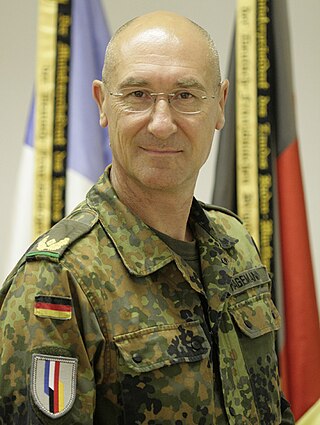
Georg Leo Graf von Caprivi de Caprara de Montecuccoli was a German general and statesman who served as the chancellor of the German Empire from March 1890 to October 1894. Caprivi promoted industrial and commercial development, and concluded numerous bilateral treaties for reduction of tariff barriers. However, this movement toward free trade angered the conservative agrarian interests, especially the Junkers. He promised educational reforms to the Catholic Center party which would increase their influence, but failed to deliver. As part of Kaiser Wilhelm's "new course" in foreign policy, Caprivi abandoned Bismarck's military, economic, and ideological cooperation with the Russian Empire, which historians consider a major mistake. Even worse, Caprivi misjudged multiple opportunities to open good relations with the United Kingdom of Great Britain and Ireland. Frustrated, Britain turned to the Empire of Japan and the French Third Republic for agreements. Caprivi's downfall came with trade agreements that favored German industry and urban workers over more powerful agricultural interests. Historians praise his refusal to renew the harsh restrictions on socialists, and his success in the reorganization of the German military.

Prince Henry of Prussia was a younger brother of German Emperor William II and a Prince of Prussia. He was also a grandson of Queen Victoria. A career naval officer, he held various commands in the Imperial German Navy and eventually rose to the rank of Grand Admiral and Generalinspekteur der Marine.

The Order of the Black Eagle was the highest order of chivalry in the Kingdom of Prussia. The order was founded on 17 January 1701 by Elector Friedrich III of Brandenburg. In his Dutch exile after World War I, deposed Emperor Wilhelm II continued to award the order to his family. He made his second wife, Princess Hermine Reuss of Greiz, a Lady in the Order of the Black Eagle.

The Order of the Red Eagle was an order of chivalry of the Kingdom of Prussia. It was awarded to both military personnel and civilians, to recognize valor in combat, excellence in military leadership, long and faithful service to the kingdom, or other achievements. As with most German orders, the Order of the Red Eagle could only be awarded to commissioned officers or civilians of approximately equivalent status. However, there was a medal of the order, which could be awarded to non-commissioned officers and enlisted men, lower ranking civil servants and other civilians.

Prince Oskar Karl Gustav Adolf of Prussia was the fifth son of German Emperor Wilhelm II and Augusta Victoria of Schleswig-Holstein-Sonderburg-Augustenburg.

William, Duke of Brunswick, was ruling duke of the Duchy of Brunswick from 1830 until his death.

Paulina Clarissa Molony, known professionally as Saharet, was an Australian dancer who performed in vaudeville music houses as well as in Broadway productions in the United States as well as in Europe, earning considerable fame and notoriety.

Prince Friedrich Leopold of Prussia was a son of Prince Frederick Charles of Prussia and Princess Maria Anna of Anhalt-Dessau, married in 1854.

Helmuth Ludwig Wilhelm Freiherr von Maltzahn was a German finance minister and a representative in the Reichstag.

Wilhelm Gustav Karl Bernhard von Hahnke was a Prussian Field Marshal, and Chief of the German Imperial Military Cabinet from 1888 to 1901.

The Book of Truth and Facts was originally released in 1914 by Friedrich Wilhelm von Frantzius. It was published during World War I and functioned as a piece of pro-German propaganda. The booklet was written in response to an article entitled "Germans as Exponents of Culture" penned by Brander Matthews, which appeared in the September 20, 1914 edition of the New York Times2.

General of the Infantry is a former rank of the German army. It is currently an appointment or position given to an OF-8 rank officer, who is responsible for particular affairs of training and equipment of the Bundeswehr infantry.
Hans Karl Georg von Kaltenborn-Stachau was a Prussian General of the Infantry and Minister of War.

Victor I, Duke of Ratibor, Prince of Corvey, Prince of Hohenlohe-Schillingsfürst was a member of House of Hohenlohe-Schillingsfürst and later Duke of the Silesian duchy of Ratibor and Prince of Corvey.

Victor II, Duke of Ratibor, Prince of Corvey, Prince of Hohenlohe-Schillingsfürst was a member of the House of Hohenlohe-Schillingsfürst and Duke of the Silesian duchy of Ratibor.

Prince Friedrich Wilhelm Ludwig Alexander of Prussia was the eldest child of Prince Frederick of Prussia and his wife, Princess Luise of Anhalt-Bernburg.

Theodor von Holleben was a German diplomat.

Bohuslav, Count Chotek von Chotkow und Wognin was a Bohemian nobleman, landowner, and a diplomat in the service of Austria-Hungary. He was the father of Sophie, Duchess of Hohenberg, the morganatic wife of Archduke Franz Ferdinand of Austria.

Gustav Friedrich Beyer was a Prussian general and war minister of the Grand Duchy of Baden.


















